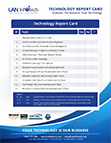Kids Can’t Protect Themselves: 8 Ways to Safeguard Private Student Information…
In this digital age, so much information is sent and received online, made public as a result of things like social media, but in this age of information, privacy can be hard to secure, and when it comes to things like student records, administrators are expected to keep this information private and assure any sensitive data is properly protected.
Here’s the problem: when schools fail to properly protect student information, kids are left in a vulnerable place – letting confidential details like student names, addresses, emails, and other details be available to hackers. Discussed below are 8 of the best practices to assure student information and records are kept safe and secure:
- Establish Security Objectives
Districts and individual schools must establish a set of security objectives, so they can properly develop appropriate policies and procedures for protecting student data. Every sector has individualized objectives to protect things, such as integrity and confidentiality, and the education industry is no exception.
Security objectives in education should be focused on legal obligations regarding privacy and security, as well as facilitating the appropriate, educational use of data.
- Data Mapping
Data mapping is crucial in creating and adopting all of the necessary security safeguards, and identifying all of the data is of the utmost importance. Data mapping throughout the entire enterprise and all related systems will enable adequate security planning, and help system administrators determine what information is being held, how sensitive this data is, any risks or concerns associated with such data, and the potential impact of a data loss.
It is critical there be a strong understanding of the various data elements that are collected and used to ensure the correct evaluation of legal obligations that may apply to the collection and use of such data.
- Training
It is important that all employees be properly trained, in order to have and maintain an effective security program. Everyone involved should be familiar with, and have a basic knowledge and understanding of, issues that create and surround student privacy and data security risks.
- Conduct a Risk Assessment
Before any data security program can be fine tuned, the district or school will need to properly assess their current practices and policies. Before beginning a risk assessment to identify security needs, it is important that there be a proper review of all the technologies, people, and processes being used for student data governance.
- Reporting, Auditing and Monitoring
Monitoring is an important aspect to any security program, and requires both internal and external partnerships in order to be effective. All security programs require routine testing and monitoring to check for security threats, as well as regular updating.
Continuous monitoring is necessary, which involves real time monitoring and updating to remain protected. In order to maintain credibility, there must be regular auditing of security programs by qualified personnel to protect data privacy. It is critical that well defined protocols be in place to be able to identify and address data breaches.
- Third Party Relationships
It is important that third party relationships and vendor agreements be properly managed by executing risk assessments before contracting vendors and having governance framework in place. Legal counsel, as well as technical experts, will be needed for drafting agreements that include necessary data protections and constraints on the use of data.
- Breach Procedures
Districts and schools need to have a breach provision plan in place, that addresses the minimum required procedures for monitoring, and for when a breach is discovered, as well as who is responsible for notifying government authorities and the affected parties should a security breach occur.
- Accountability
Accountability is critical in ensuring effectiveness of the drafted and implemented policies and procedures. Employers must be held accountable when a violation occurs, and this is done through coordination with human resources to determine how data privacy and security policies are enforced and handled.
We Know Kids Put Their Private Information at Risk, But Why Aren’t You Setting a Better Example?
LAN Infotech is here to help you protect the children within your educational institution through proper data security measures. Call (954) 717-1990 or send us an email at sales@laninfotech.com for more information.

LAN Infotech is a Microsoft Cloud Services Provider, IT Managed Support company and a leader in helping law firms, nonprofits and medical organizations deploy cloud solutions, manage computer networks, keep data protected and top technology management company. Businesses like yours need technology support to run highly-effective organizations.



